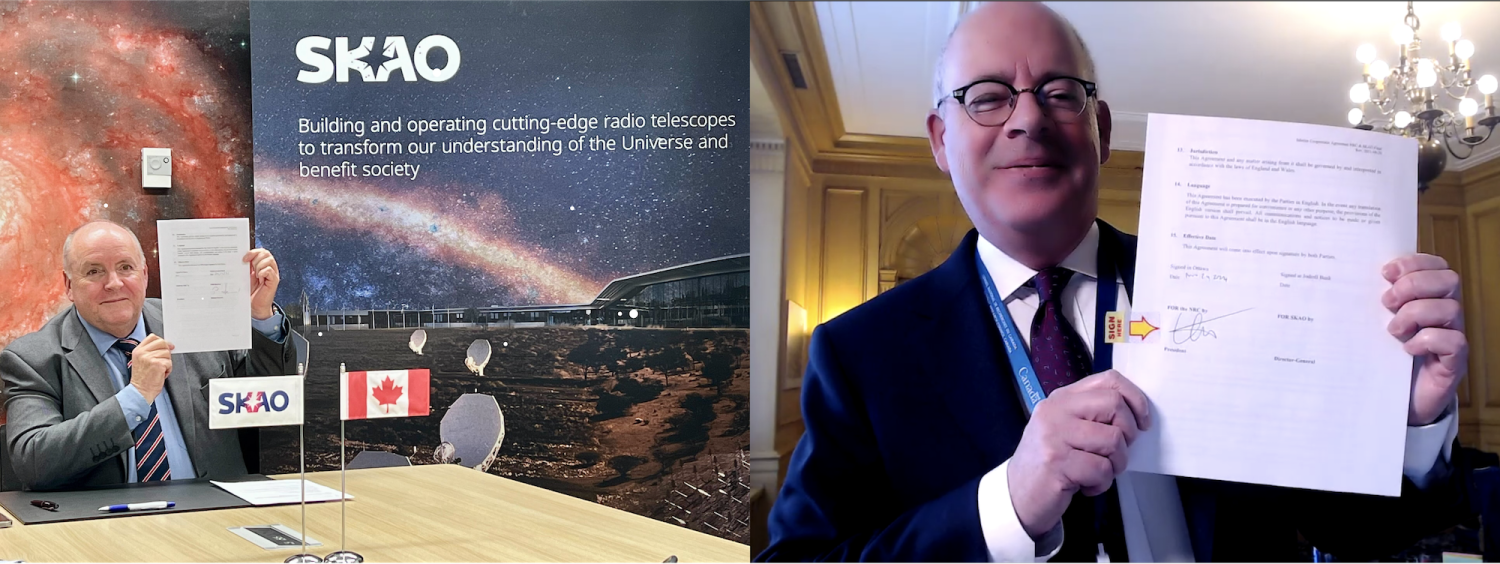SKAO signs agreement with Canada’s National Research Council

The NRC will deliver the digital correlator, the “brain” behind the SKAO’s telescope in South Africa. The agreement also allows Canada’s scientific and engineering communities to continue participation in the project.
Access to SKA a top priority
Canada has been a member of the SKAO’s predecessor, the SKA Organisation, since its creation in 2011 and has been involved in the SKA Project from its earliest stages. Canadian astronomers have identified access to the SKA as a top priority in their decadal Long-Range Plans in 2000, 2010, and 2020. Scientists from across the country participate in nearly all SKAO science working groups, covering the gamut from the astronomical systems that are thought to form the cradle of life, to the earliest properties of our Universe.
“This agreement is important in solidifying Canada’s ongoing interest in the SKA Observatory through the National Research Council of Canada,” said Prof Phil Diamond, SKAO Director-General. “Our Canadian colleagues have been key partners in the SKA Project since its inception, with significant contributions to the design of our telescopes. We look forward to continuing discussions with the NRC and the Canadian government about membership.”
Dr Kristine Spekkens, Canada’s SKA Science Director and Professor at the Royal Military College of Canada and Queen’s University, said: “The SKA will be a fantastic facility that will enable Canadian astronomers to make important new discoveries about how the Universe works. The synergy between the capabilities of the SKA and the expertise of many Canadian astronomers is a key reason for the SKA’s high priority within our community.”
Spin-offs to help advance other industries
While an optical telescope captures only the visible light from the electromagnetic spectrum, radio telescopes reveal the radio portion of the spectrum emitted from objects in space. When received by telescopes, these distant signals are both faint and buried in noise.
Canadian data processing technology – developed by the NRC’s Herzberg Astronomy and Astrophysics Research Centre and industry partner MDA – is behind the extraordinary effort to identify and measure the weak signals from space in the large data stream coming from the SKA telescope in South Africa. Technical contributions to the SKAO telescopes have spin-off applications, which will help to advance other, far-reaching industries, from data centres to satellite communications, robotics, and more.
“This agreement will support leading-edge astronomy, and create opportunities for Canadian industry with applications in areas such as telecommunications, consumer electronics and data centres, and open doors for ground-breaking discoveries by Canadian astronomers,” said NRC President Iain Stewart. “We are pleased to continue collaboration with our international partners on this transformative science facility.”
Positive socio-economic impacts already generated
Beyond transformative science and technology, impacts on society and communities have been a core consideration of the SKAO’s mission. In particular, respecting Indigenous cultures and the local populations, and engaging positively with them, has been a key consideration for the SKA Project since early in its design phase. These core principles are well aligned with the priorities of the Canadian astronomical community as expressed in the 2020 Long Range Plan for Canadian Astronomy.
SKAO and its precursor and pathfinder facilities around the world have already generated socio-economic impacts in a number of areas. These range from creating employment for local communities, boosting local education and local astro-tourism, to celebrating artists and ancient cultural wisdom from the Australian and South African sites through the Shared Sky Indigenous astronomy and art exhibition. Building upon this, the SKAO will impact four core areas: the economy; society; sustainability and culture; and will contribute to addressing the United Nations’ Sustainable Development Goals.




